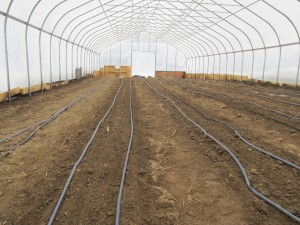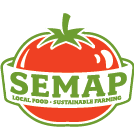BY DEREK CHRISTIANSON
 Hard to imagine amid the spring thaw and abundance of moisture from the melt that our minds turned toward irrigation on the farm this past week. We spent the early part of this past Thursday bringing surface irrigation lines to our recently reassembled field house. Although we typically run mini-wobblers in the fieldhouse to ensure good germination of greens, we took the time to set up our drip irrigation system which will be utilized when our summertime nightshades replace the greens in early May. So out came header lines, drip line fittings, & drip tape, carried through the icy snow.
Hard to imagine amid the spring thaw and abundance of moisture from the melt that our minds turned toward irrigation on the farm this past week. We spent the early part of this past Thursday bringing surface irrigation lines to our recently reassembled field house. Although we typically run mini-wobblers in the fieldhouse to ensure good germination of greens, we took the time to set up our drip irrigation system which will be utilized when our summertime nightshades replace the greens in early May. So out came header lines, drip line fittings, & drip tape, carried through the icy snow.
Over the years we utilized a number of different suppliers for irrigation supplies on the farm, including Nolt’s Produce Supply in Pennsylvania. Brookdale Fruit Farm is popular regional resource utilized by many growers (located in Hollis, NH) in Eastern Massachusetts. Closer to home Progressive Grower carries a full line of irrigation supplies and is a good place to start. If folks are new to setting up drip irrigation, we highly recommend having a conversation with a well informed sales agent. We typically feel it’s worthwhile to download a copy (or request a hard copy) of the current Rain-Flo Catalog, which includes an abundance of information about setting up a new drip irrigation system. Trickl-eez is another faraway supplier which has a great catalog, for reference purposes. For growers inclined toward low-tech options, ATTRA responded to one grower’s question regarding Gravity Fed Drip Systems.
For those growers with NRCS conservation plan we suggest you check in with your NRCS agent regarding the potential for cost-share allocations for drip irrigation and irrigation systems in general. In general, I’ve yet to find better resources on technical information regarding irrigation than the University of Florida- go figure… The University of Florida hosts a long list of general irrigation publications…to start see: Water Measurement for Agricultural Irrigation and Drainage Systems .
- Consider installing a “Fertigation” Siphon Injector depending on water quality… we are using ours to help reduce chloramine availabilty in our greenhouse water (since we are on town water on the new farm and drilling a well is slated as a Summer 2015 or 2016 expense). Three options for fertigation listed below (for different scale) – by the way we are going to be using Vitamin C to work on the chloramines… and we typically add a liquid kelp to help stimulate growth and germination in the prop house.
For the past few years, we’ve been happy using a simple Hozon Brass Siphon Mixer widely available, $25-30 plus s&h, it’s good for greenhouse use watering starts though recommended for use with no more than a 50 foot hose beyond the siphon point to ensure adequate intake from the feeder tank (a 5 gallon bucket on our farm).
- Mazzei Injector (we purchased ours from Nolt’s – pre-fabricated with a bypass and pressure gauge) See Mazzei for more information or DripWorks for a different supplier option. These are good for field scale fertigation on the small scale.
Of course the Dosatron is widely used by conventional greenhouse growers and is typically well worth the investment if you are managing chemicals and nutrients in the greenhouse on a decent scale or complexity.
With the delayed onset of field activities this spring, now is a good time to take a critical look at your farming systems and determine if it is wise to make an improvement or upgrade ahead of the growing season. Setting up systems in the greenhouse is a way for us to help our new crew become familiar with irrigation on the farm long before the critical irrigation season arrives, making implementation during the high season much smoother.
Enjoy the melt & the mud,
Derek
